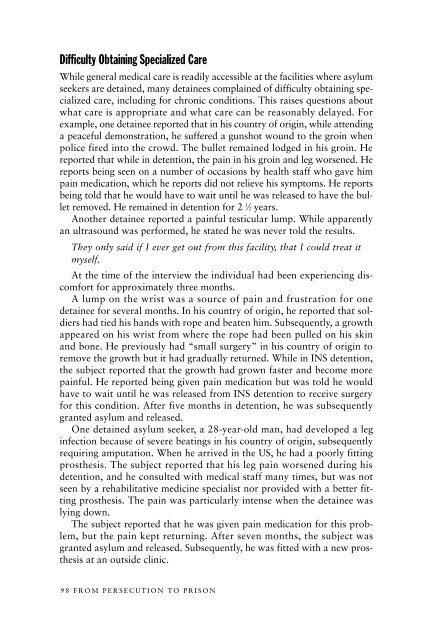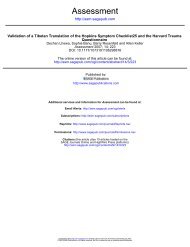From Persecution to Prison - Bellevue/NYU Program for Survivors of ...
From Persecution to Prison - Bellevue/NYU Program for Survivors of ...
From Persecution to Prison - Bellevue/NYU Program for Survivors of ...
Create successful ePaper yourself
Turn your PDF publications into a flip-book with our unique Google optimized e-Paper software.
Difficulty Obtaining Specialized CareWhile general medical care is readily accessible at the facilities where asylumseekers are detained, many detainees complained <strong>of</strong> difficulty obtaining specializedcare, including <strong>for</strong> chronic conditions. This raises questions aboutwhat care is appropriate and what care can be reasonably delayed. Forexample, one detainee reported that in his country <strong>of</strong> origin, while attendinga peaceful demonstration, he suffered a gunshot wound <strong>to</strong> the groin whenpolice fired in<strong>to</strong> the crowd. The bullet remained lodged in his groin. Hereported that while in detention, the pain in his groin and leg worsened. Hereports being seen on a number <strong>of</strong> occasions by health staff who gave himpain medication, which he reports did not relieve his symp<strong>to</strong>ms. He reportsbeing <strong>to</strong>ld that he would have <strong>to</strong> wait until he was released <strong>to</strong> have the bulletremoved. He remained in detention <strong>for</strong> 2 1 ⁄2 years.Another detainee reported a painful testicular lump. While apparentlyan ultrasound was per<strong>for</strong>med, he stated he was never <strong>to</strong>ld the results.They only said if I ever get out from this facility, that I could treat itmyself.At the time <strong>of</strong> the interview the individual had been experiencing discom<strong>for</strong>t<strong>for</strong> approximately three months.A lump on the wrist was a source <strong>of</strong> pain and frustration <strong>for</strong> onedetainee <strong>for</strong> several months. In his country <strong>of</strong> origin, he reported that soldiershad tied his hands with rope and beaten him. Subsequently, a growthappeared on his wrist from where the rope had been pulled on his skinand bone. He previously had “small surgery” in his country <strong>of</strong> origin <strong>to</strong>remove the growth but it had gradually returned. While in INS detention,the subject reported that the growth had grown faster and become morepainful. He reported being given pain medication but was <strong>to</strong>ld he wouldhave <strong>to</strong> wait until he was released from INS detention <strong>to</strong> receive surgery<strong>for</strong> this condition. After five months in detention, he was subsequentlygranted asylum and released.One detained asylum seeker, a 28-year-old man, had developed a leginfection because <strong>of</strong> severe beatings in his country <strong>of</strong> origin, subsequentlyrequiring amputation. When he arrived in the US, he had a poorly fittingprosthesis. The subject reported that his leg pain worsened during hisdetention, and he consulted with medical staff many times, but was notseen by a rehabilitative medicine specialist nor provided with a better fittingprosthesis. The pain was particularly intense when the detainee waslying down.The subject reported that he was given pain medication <strong>for</strong> this problem,but the pain kept returning. After seven months, the subject wasgranted asylum and released. Subsequently, he was fitted with a new prosthesisat an outside clinic.98 FROM PERSECUTION TO PRISON



